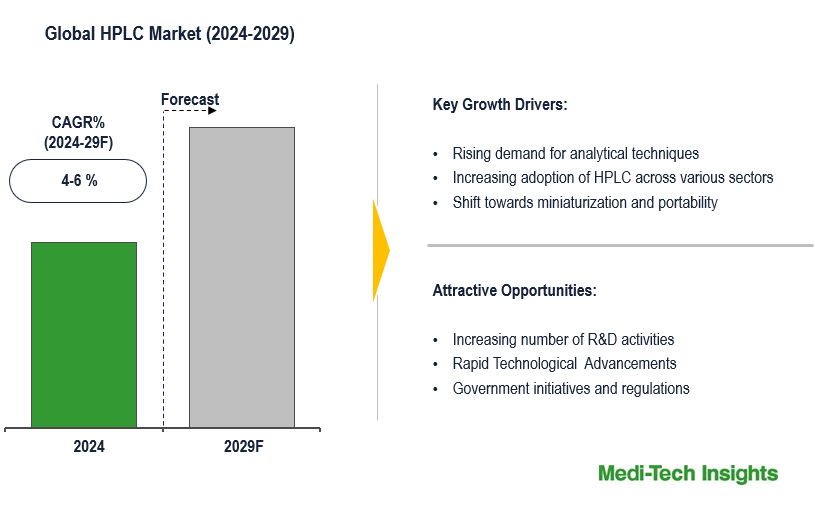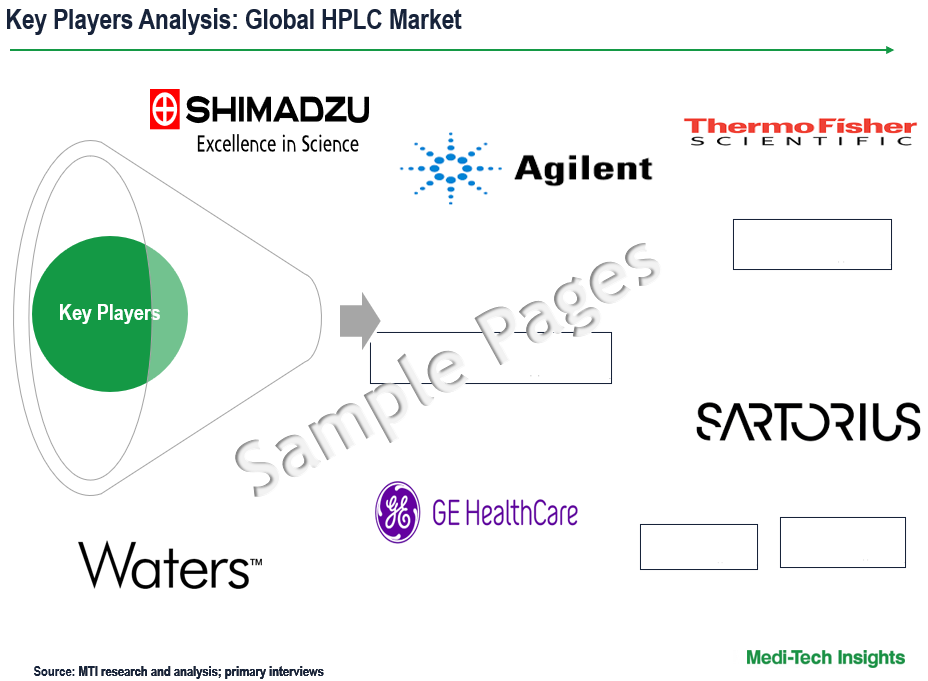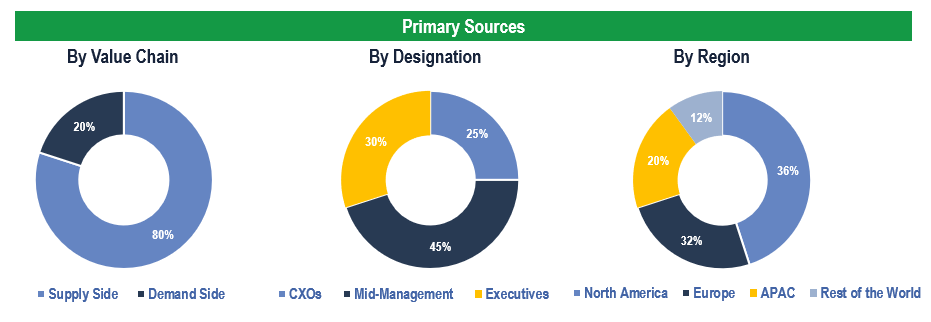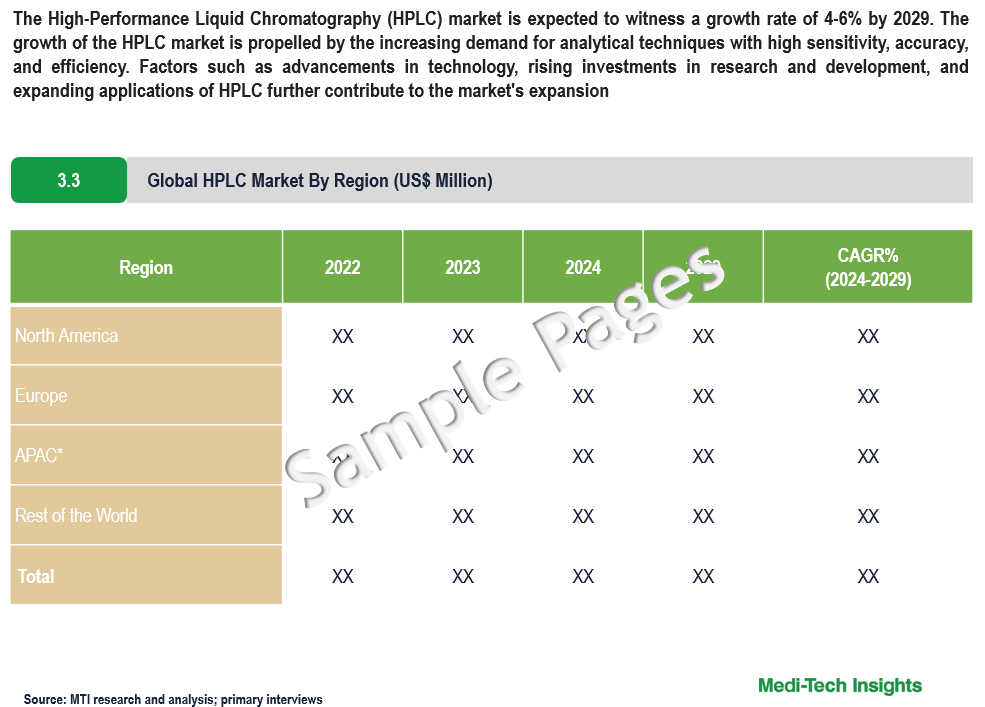
High-Performance Liquid Chromatography (HPLC) Market: Size, Advancements and Trends 2024 to 2029
The High-Performance Liquid Chromatography (HPLC) market is expected to witness a growth rate of 4-6% by 2029. The growth of the HPLC market is propelled by the increasing demand for analytical techniques with high sensitivity, accuracy, and efficiency. Factors such as technological advancements, rising investments in research and development, and expanding applications of HPLC further contribute to the market’s expansion. To learn more about the research report, download a sample report.
High-performance liquid chromatography (HPLC) stands as a robust analytical method utilized for the separation, detection, and quantification of various components within a mixture. Functioning on chromatographic principles, HPLC involves the passage of a sample mixture through a stationary phase, typically housed within a column, under high pressure. This process enables the components to interact differently with the stationary phase, thereby facilitating their separation based on distinct chemical properties. Essential components of an HPLC system encompass the pump for generating and sustaining high pressure, the injector for introducing samples into the mobile phase, the column packed with a stationary phase material for separation, the detector for monitoring eluent leaving the column, and the data acquisition system for processing detector signals to produce chromatograms. The versatility of HPLC finds application across various fields including pharmaceutical analysis, environmental testing, food and beverage analysis, and forensic science, owing to its high sensitivity, selectivity, and capability to analyze a broad spectrum of compounds, rendering it an indispensable tool in contemporary analytical laboratories.
Analytical Evolution: HPLC's Role in Industry Growth and Innovation
HPLC finds extensive applications across diverse industries such as pharmaceuticals, biotechnology, food and beverage, environmental analysis, forensic science, and more. Recent advancements in HPLC technology focus on improving resolution, sensitivity, speed, and automation. This includes the development of new column chemistries, improved detectors (such as mass spectrometry coupled with HPLC), and innovative software for data analysis and instrument control. The growing need for accurate and reliable analytical techniques in these sectors drives the demand for HPLC systems. For instance,
- In March 2023, Waters unveiled the Next-Generation Alliance iS HPLC System, which aims to reduce up to 40% of common lab errors. This system integrates seamlessly with Waters Empower™ Chromatography Software and eConnect™ HPLC Columns, enhancing laboratory efficiency and productivity
Stringent regulatory requirements in industries such as pharmaceuticals and food safety mandate the use of reliable analytical techniques like HPLC for quality control, testing, and compliance purposes, drive the adoption of HPLC systems and fuels market growth. The globalization of industries and the expansion of emerging markets create new opportunities for HPLC manufacturers. There's a growing emphasis on sustainability and green chemistry practices in the HPLC market. Manufacturers are developing eco-friendly solvents, reducing solvent consumption, and designing recyclable or biodegradable components to minimize the environmental impact of HPLC analysis. Growing awareness about the benefits of HPLC technology, and increased investment in research and development, coupled with rising demand from emerging economies, drives market growth.

To learn more about this report, download the PDF brochure
Expanding Applications: HPLC's Journey into Advanced Analytical Fields
HPLC's application scope is expanding into new areas such as metabolomics, proteomics, lipidomics, and glycobiology. Researchers are developing novel HPLC methods and protocols to address the growing demand for analyzing complex biological samples and elucidating intricate molecular pathways. There's a growing trend towards miniaturization and portability of HPLC systems, enabling on-site analysis in various settings including field research, environmental monitoring, and point-of-care diagnostics which facilitates faster decision-making and reduces the need for sample transportation. Manufacturers are working on enhancing the efficiency and throughput of HPLC systems. This involves the development of faster separation techniques, high-resolution columns, and automated sample handling capabilities to streamline the analysis process and increase sample throughput.
With the advent of advanced data processing algorithms and software tools, there's a focus on improving data analysis and interpretation in HPLC. This includes the integration of machine learning and artificial intelligence techniques to automate peak detection, quantification, and compound identification, thereby enhancing the reliability and accuracy of results. HPLC is increasingly being combined with other analytical techniques, such as mass spectrometry (LC-MS) or nuclear magnetic resonance spectroscopy (LC-NMR), to provide comprehensive analysis of complex samples. These hyphenated techniques offer improved sensitivity, selectivity, and structural elucidation capabilities HPLC systems are being optimized for high-throughput screening applications, particularly in drug discovery and development. This involves the integration of automation and robotics to accelerate sample processing and data analysis, leading to faster drug candidate identification and characterization. These emerging trends and advancements drive the growth of the High-Performance Liquid Chromatography market, enhancing capabilities for complex sample analysis. For instance,
- In February 2024, Waters Corporation unveiled the HPLC CONNECT software, facilitating seamless digital synchronization between its high-performance liquid chromatography (HPLC/UPLC) systems and multi-angle light-scattering instruments (MALS) from the Wyatt Technology™ portfolio, providing enhanced efficiency and confidence for scientists conducting size exclusion chromatography and MALS (SEC-MALS) analyses, particularly for complex biopharmaceutical innovations like antibody-drug conjugates, other intricate protein conjugates, and gene therapies
Key Constraints/Challenges
The HPLC market encounters numerous challenges, including high initial investment and maintenance costs, particularly daunting for smaller laboratories. The complexity of HPLC systems necessitates specialized training for operation and maintenance, posing difficulties for users lacking expertise. Stringent regulatory standards, especially in pharmaceuticals and food safety sectors, contribute to the complexity and cost of HPLC implementation. Analyzing complex samples presents method development, resolution, and sensitivity challenges, while environmental concerns surrounding solvent usage drive the need for eco-friendly alternatives and sustainable practices. Addressing these obstacles mandates continuous innovation, cost-effective solutions, streamlined regulatory processes, and environmental stewardship to foster advancement within the HPLC market.
Global Outlook: Regional Dynamics and Growth Prospects in the HPLC Market
North America is poised to dominate the HPLC market, buoyed by its dense concentration of pharmaceutical and biotechnology firms, along with established research institutions. Particularly, the United States stands out as a primary driver of market expansion, propelled by continuous technological advancements and substantial investments in research and development. Similarly, Europe emerges as a pivotal market for HPLC, with notable contributions from countries such as Germany, the United Kingdom, and France. Here, stringent regulatory standards across industries like pharmaceuticals and food and beverage fuel demand for HPLC systems, primarily for quality control and safety measures.
Meanwhile, the Asia Pacific region anticipates significant growth in the HPLC market, propelled by the burgeoning pharmaceutical and biotechnology sectors, notably in nations like China, India, and Japan. Rising investments in healthcare infrastructure and research, coupled with increasing awareness of HPLC technology's benefits, underpin market expansion in this dynamic region.
Competitive Landscape
Key players in the HPLC market include Agilent Technologies Inc., Shimadzu Corporation, Waters Corporation, Thermo Fisher Scientific Inc., PerkinElmer Inc., Sartorius AG, Bio-Rad Laboratories, Inc., Merck KGaA and Gilson among others.

Get a sample report for competitive landscape analysis
Organic and Inorganic Growth Strategies Adopted by Players to Establish Their Foothold in the Market
Players operating in this market are adopting both organic and inorganic growth strategies such as collaborations, and acquisitions to garner market share. For instance,
- In June 2022, Thermo Fisher Scientific Inc. introduced its Thermo Scientific µPAC Neo HPLC micro-pillar array column as a component of an integrated LC-MS workflow, aimed at streamlining complex bottom-up proteomics analyses by providing exceptional separation performance across various flow rates, thus enabling ultra-high resolution for extracting comprehensive information from intricate samples.
- In February 2022, Sartorius, through its subgroup Sartorius Stedim Biotech, completed the acquisition of the Novasep chromatography division, primarily consisting of chromatography systems tailored for smaller biomolecules like oligonucleotides, peptides, and insulin, along with innovative systems for continuous biologics manufacturing
The HPLC Market is expected to gain momentum in the coming years due to the rising demand for analytical techniques, the shift towards miniaturization and portability of HPLC systems, technological advancements, strategic collaborations and aggressive organic and inorganic growth strategies followed by the players.
Key Strategic Questions Addressed
-
What is the market size & forecast for the Global HPLCMarket?
-
What are the historical, present, and forecasted market shares and growth rates of various segments and sub-segments of the Global HPLC Market?
-
How has COVID-19 impacted the Global HPLC Market?
-
What are the major growth drivers, restraints/challenges impacting the market?
-
What are the opportunities prevailing in the market?
-
What is the investment landscape?
-
Which region has the highest share in the global market? Which region is expected to witness the highest growth rate in the next 5 years?
-
Who are the major players operating in the market? What is the competitive positioning of key players?
-
Who are the new players entering the market?
-
What are the key strategies adopted by players?
- Research Methodology
- Secondary Research
- Primary Research
- Market Estimation
- Market Forecasting
- Executive Summary
- Market Overview
- Market Dynamics
- Drivers
- Restraints
- Opportunities
- Market Dynamics
- Global HPLC Market - Size & Forecast (2021-2028), By Product
- Instruments
- Consumables
- Softwares
- Other Products
- Global HPLC Market - Size & Forecast (2021-2028), By Application Type
- Clinical Research
- Forensic
- Diagnostics
- Other Applications
- Global HPLC Market - Size & Forecast (2021-2028), By End User
- Bio-Pharma Companies
- Academic & Research Institutes
- Other End Users
- Global HPLC Market - Size & Forecast (2021-2028), By Region
- North America (U.S. & Canada)
- Europe (UK, Germany, France, Italy, Spain, Rest of Europe)
- Asia Pacific (China, India, Japan, Rest of Asia Pacific)
- Rest of the World (Latin America, Middle East & Africa)
- Competitive Landscape
- Key Players and their Competitive Positioning
- Competitive Positioning of Key Players (2022)
- Offerings Assessment, By Players
- Key Strategies Assessment, By Player (2021-2023)
- New Product Launches
- Partnerships, Agreements, & Collaborations
- Mergers & Acquisitions
- Other Developments
- Key Players and their Competitive Positioning
- Key Companies Scanned (Indicative List)
- Agilent Technologies Inc.
- Shimadzu Corporation
- Waters Corporation
- Thermo Fisher Scientific Inc.
- PerkinElmer Inc.
- Sartorius AG
- Bio-Rad Laboratories, Inc.
- Merck KGaA
- Gilson
- Other Players
The study has been compiled based on extensive primary and secondary research.
Secondary Research (Indicative List)
 Primary Research
Primary Research
To validate research findings (market size & forecasts, market segmentation, market dynamics, competitive landscape, key industry trends, etc.), extensive primary interviews were conducted with both supply and demand-side stakeholders.
Supply Side Stakeholders:
- Senior Management Level: CEOs, Presidents, Vice-Presidents, Directors, Chief Technology Officers, Chief Commercial Officers
- Mid-Management Level: Product Managers, Sales Managers, Brand Managers, Business Development Managers, Consultants
Demand Side Stakeholders:
- Stakeholders in Bio-Pharma Companies, and Academic & Research Institutes among others
Breakdown of Primary Interviews

Market Size Estimation
Both ‘Top-Down and Bottom-Up Approaches’ were used to derive market size estimates and forecasts.
Data Triangulation
Research findings derived through secondary sources & internal analysis were validated with Primary Interviews, Internal Knowledge Repository, and Company Sales Data.


